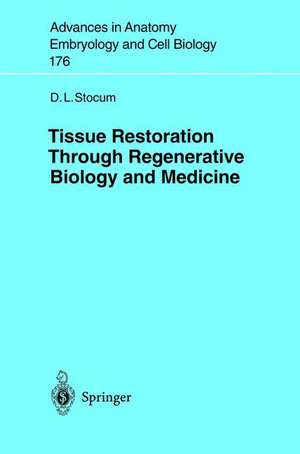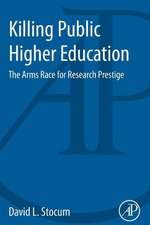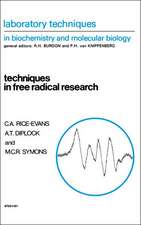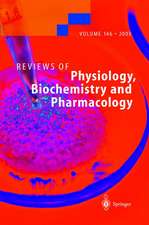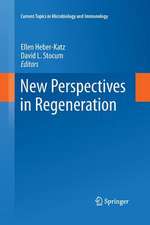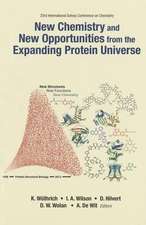Tissue Restoration Through Regenerative Biology and Medicine: Advances in Anatomy, Embryology and Cell Biology, cartea 176
Autor David L. Stocumen Limba Engleză Paperback – 24 feb 2004
How far can we go in our quest for regeneration? We will probably be able to induce the regeneration of some tissues, such as skin or even spinal cord, within a few years. The regeneration of others, such as heart, lung, kidney or appendages, may be more complex and difficult, but we should not view them as impossible. They will just take a little longer.
Din seria Advances in Anatomy, Embryology and Cell Biology
- 5%
 Preț: 1146.33 lei
Preț: 1146.33 lei - 5%
 Preț: 721.19 lei
Preț: 721.19 lei - 15%
 Preț: 637.13 lei
Preț: 637.13 lei -
 Preț: 381.81 lei
Preț: 381.81 lei - 15%
 Preț: 644.95 lei
Preț: 644.95 lei - 5%
 Preț: 1025.16 lei
Preț: 1025.16 lei - 15%
 Preț: 689.97 lei
Preț: 689.97 lei - 15%
 Preț: 577.07 lei
Preț: 577.07 lei - 15%
 Preț: 580.36 lei
Preț: 580.36 lei - 5%
 Preț: 393.51 lei
Preț: 393.51 lei -
 Preț: 408.66 lei
Preț: 408.66 lei -
![Die Schlüpfdrüse der Geburtshelferkröte (Alytes o. obstetricans [LAURENTI]) und anderer Froschlurche](https://i4.books-express.ro/bs/9783662239742/die-schluepfdruese-der-geburtshelferkroete-alytes-o-obstetricans-laurenti-und-anderer-froschlurche.jpg) Preț: 408.27 lei
Preț: 408.27 lei - 5%
 Preț: 1090.61 lei
Preț: 1090.61 lei - 5%
 Preț: 705.11 lei
Preț: 705.11 lei - 5%
 Preț: 706.04 lei
Preț: 706.04 lei - 5%
 Preț: 357.61 lei
Preț: 357.61 lei - 5%
 Preț: 704.59 lei
Preț: 704.59 lei - 5%
 Preț: 705.11 lei
Preț: 705.11 lei - 5%
 Preț: 359.42 lei
Preț: 359.42 lei - 5%
 Preț: 711.52 lei
Preț: 711.52 lei - 15%
 Preț: 635.47 lei
Preț: 635.47 lei - 15%
 Preț: 631.72 lei
Preț: 631.72 lei - 15%
 Preț: 633.35 lei
Preț: 633.35 lei - 15%
 Preț: 632.37 lei
Preț: 632.37 lei - 5%
 Preț: 706.60 lei
Preț: 706.60 lei - 15%
 Preț: 631.07 lei
Preț: 631.07 lei - 5%
 Preț: 707.13 lei
Preț: 707.13 lei - 5%
 Preț: 707.33 lei
Preț: 707.33 lei - 5%
 Preț: 359.60 lei
Preț: 359.60 lei - 5%
 Preț: 707.69 lei
Preț: 707.69 lei - 5%
 Preț: 707.13 lei
Preț: 707.13 lei - 5%
 Preț: 708.06 lei
Preț: 708.06 lei - 5%
 Preț: 706.41 lei
Preț: 706.41 lei - 5%
 Preț: 708.78 lei
Preț: 708.78 lei - 5%
 Preț: 705.68 lei
Preț: 705.68 lei - 5%
 Preț: 705.11 lei
Preț: 705.11 lei - 5%
 Preț: 706.77 lei
Preț: 706.77 lei - 15%
 Preț: 635.15 lei
Preț: 635.15 lei - 15%
 Preț: 631.07 lei
Preț: 631.07 lei - 5%
 Preț: 706.77 lei
Preț: 706.77 lei - 5%
 Preț: 706.04 lei
Preț: 706.04 lei - 5%
 Preț: 710.79 lei
Preț: 710.79 lei - 5%
 Preț: 705.32 lei
Preț: 705.32 lei - 15%
 Preț: 633.19 lei
Preț: 633.19 lei - 15%
 Preț: 629.09 lei
Preț: 629.09 lei - 15%
 Preț: 633.53 lei
Preț: 633.53 lei - 15%
 Preț: 632.70 lei
Preț: 632.70 lei - 15%
 Preț: 633.68 lei
Preț: 633.68 lei - 18%
 Preț: 773.72 lei
Preț: 773.72 lei - 15%
 Preț: 630.43 lei
Preț: 630.43 lei
Preț: 359.05 lei
Preț vechi: 377.95 lei
-5% Nou
Puncte Express: 539
Preț estimativ în valută:
68.73€ • 74.68$ • 57.77£
68.73€ • 74.68$ • 57.77£
Carte tipărită la comandă
Livrare economică 21 aprilie-05 mai
Preluare comenzi: 021 569.72.76
Specificații
ISBN-13: 9783540206033
ISBN-10: 3540206035
Pagini: 116
Ilustrații: VIII, 104 p. 3 illus.
Dimensiuni: 155 x 235 x 6 mm
Greutate: 0.18 kg
Ediția:Softcover reprint of the original 1st ed. 2004
Editura: Springer Berlin, Heidelberg
Colecția Springer
Seria Advances in Anatomy, Embryology and Cell Biology
Locul publicării:Berlin, Heidelberg, Germany
ISBN-10: 3540206035
Pagini: 116
Ilustrații: VIII, 104 p. 3 illus.
Dimensiuni: 155 x 235 x 6 mm
Greutate: 0.18 kg
Ediția:Softcover reprint of the original 1st ed. 2004
Editura: Springer Berlin, Heidelberg
Colecția Springer
Seria Advances in Anatomy, Embryology and Cell Biology
Locul publicării:Berlin, Heidelberg, Germany
Public țintă
ResearchCuprins
1 Introduction.- 1.1 The Biology of Regeneration.- 1.2 Regeneration of Ectodermal Derivatives.- 1.3 Regeneration of Endodermal Derivatives.- 1.4 Regeneration of Mesodermal Derivatives.- 1.5 Developmental Potential of Adult Stem Cells.- Regenerative Medicine.- 2.1 Cell Transplants.- 2.2 Chemical Induction of Regeneration In Vivo.- 3 Perspectives.- References.
Textul de pe ultima copertă
The cost of tissue damage due to degenerative disease and injury is enormous in terms of health care costs, lost economic productivity, diminished quality of life and premature death. Advances in cell, developmental and molecular biology, and the discovery of regeneration-competent cells in many non-regenerating mammalian tissues, have given impetus to systematic investigations that will enable us to regenerate these tissues by cell transplantation or the pharmaceutical induction of regeneration from the body’s own tissues. A significant avenue of research is the identification of the soluble and insoluble signals and their transduction pathways that govern the proliferation and differentiation of regeneration-competent cells, and the signals that inhibit their activity after injury. The most direct experimental strategy to identify the chemical and physical signals that promote regeneration and the factors that inhibit it is to make genomic and proteomic comparisons, using bioinformatic analyses, of regeneration-competent vs regeneration-deficient tissues. Once identified, the molecular promoters of regeneration can be used in clinical treatments.
How far can we go in our quest for regeneration? We will probably be able to induce the regeneration of some tissues, such as skin or even spinal cord, within a few years. The regeneration of others, such as heart, lung, kidney or appendages, may be more complex and difficult, but we should not view them as impossible. They will just take a little longer.
How far can we go in our quest for regeneration? We will probably be able to induce the regeneration of some tissues, such as skin or even spinal cord, within a few years. The regeneration of others, such as heart, lung, kidney or appendages, may be more complex and difficult, but we should not view them as impossible. They will just take a little longer.
